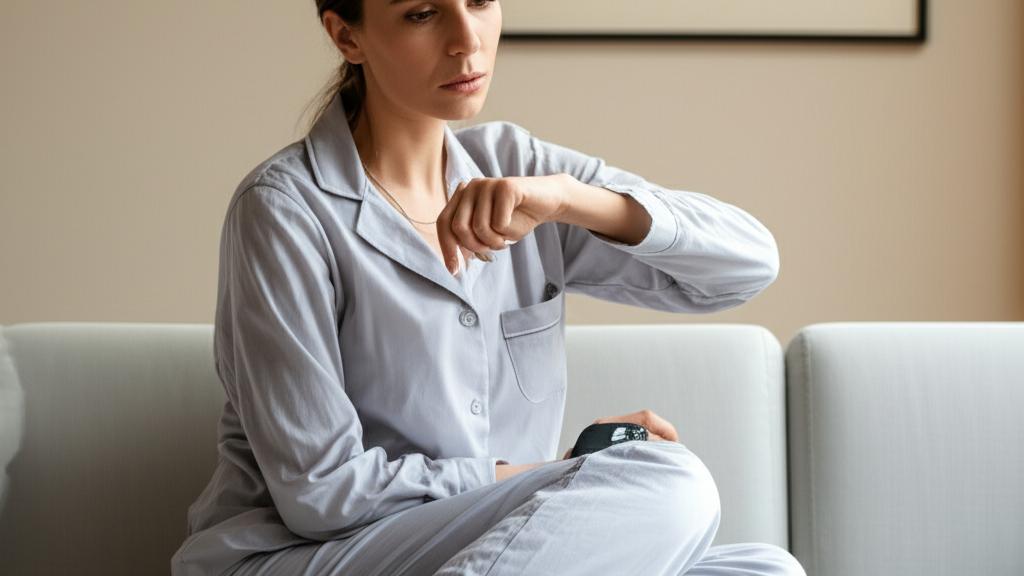A patient sat across from me, looking utterly exhausted. “doctor,” she said, “I feel like I haven’t truly slept in weeks. I go to bed, I wake up, but the whole night is a blur, and I’m tired all day.” She couldn’t pinpoint when she was waking up or for how long. It’s a story I hear often. When sleep becomes a mystery, we need clues to solve it. One of the simplest and most effective tools we have for this is actigraphy. It’s a way for us to get a real, objective look at your sleep patterns right in the comfort of your own home.
What Exactly Is Actigraphy?
Think of it as a detailed sleep diary that you don’t have to write yourself. Actigraphy is simply the measurement of your activity and your rest over a Period of time, usually from a few days up to two weeks.
We measure this using a small, watch–like device called an actigraph. I’ll ask you to wear it on your wrist or ankle. It’s not fancy—it usually doesn’t even show the time. Its only job is to sense your movement.
The core idea is simple: when you’RE moving, you’re awake. When you’re still for a long time, you’re likely asleep. By tracking these patterns 24/7, the device helps us understand:
- Roughly what time you fall asleep.
- How long it takes you to drift off.
- If you’re waking up during the night.
- The total amount of time you spend sleeping versus awake.
This isn’t a direct measurement of sleep itself—it can’t read your brainwaves. But by identifying the absence of movement, it gives us a fantastic picture of your sleep-wake cycle. Some newer actigraphs can also track light exposure and body temperature, giving us even more clues about what might be disrupting your rest.
The most important thing is to wear it continuously. If you take the device off, it just sees zero movement and assumes you’re in a deep sleep, which can throw off the results.
How We Use Actigraphy to Understand Your Sleep
So, how does this little device work its magic? Inside the actigraph is a tiny sensor called an accelerometer. It’s the same technology in your smartphone that knows when to flip the screen from vertical to horizontal. It’s incredibly sensitive to motion.
After you’ve worn the device for the prescribed time, you’ll bring it back to the clinic. We download the data, and it creates a graph. This graph is a visual story of your week. We’ll see tall, spiky bars during the day when you were active—maybe extra high spikes when you were exercising. At night, we hope to see long, flat sections, which indicate restful, uninterrupted sleep.
If the graph shows a lot of small spikes and activity throughout the night, it confirms what you’ve been feeling: your sleep is fragmented. This data helps us diagnose several common sleep disorders:
- Insomnia: Difficulty falling or staying asleep.
- Circadian Rhythm Disorders: Problems with your internal body clock, like feeling wide awake at 3 a.m. but sleepy all afternoon (delayed sleep phase syndrome).
- Hypersomnolence: Conditions that cause excessive daytime sleepiness, like narcolepsy.
It’s important to know what it can’t reliably diagnose. Because it only tracks whole-body movement, it’s not the right tool for conditions like restless legs syndrome (RLS) or periodic limb movement disorder, which involve smaller, specific leg movements.
Using Your Actigraph: A Simple Guide
Getting good data is a team effort! Here’s a quick guide on what to do when I send you home with an actigraph.
| Step | What to Do |
|---|---|
| Wear It Correctly | Secure the device on your non-dominant wrist (the one you don’t write with). It should be snug enough that it doesn’t slide around, but not uncomfortably tight. |
| Keep It On | Wear it 24/7. Don’t take it off unless you absolutely have to. Most devices are waterproof, so you can shower with them on—just double-check with me first. |
| Log Removals | If you must remove it (for example, for an MRI or contact sports), jot down the exact time you took it off and put it back on. This helps us clean up the data later. |
| Live Your Life | Don’t change your routine! We want to see what your normal sleep-wake cycle looks like. Just go about your days and nights as you usually would. |
Is This Just a Fancy Smartwatch?
That’s a great question, and the answer is no. While your Fitbit or Apple Watch uses a similar accelerometer to track steps and basic sleep, an actigraph is a medical-grade device. It’s more sensitive and has been validated in clinical studies for diagnosing sleep disorders.
Think of it this way: your smartwatch is a fantastic tool for general wellness tracking. An actigraph is a specific diagnostic tool we use to get precise data for a medical evaluation. It won’t buzz with text messages or tell you to stand up—its only purpose is to silently and accurately record your movement.
Take-Home Message
- Actigraphy is a non-invasive test that uses a wearable device (an actigraph) to track your sleep-wake patterns.
- It works by sensing movement, inferring that long periods of stillness mean you’re asleep.
- It’s a valuable tool for helping us diagnose conditions like insomnia and circadian rhythm disorders.
- For the best results, you need to wear the device continuously for the entire testing period, which could be up to two weeks.
- While similar to a fitness tracker, an actigraph is a more sensitive, medical-grade device used specifically for diagnosis.
If you’re struggling with sleep, you don’t have to just guess what’s going on in the dark. A simple test like this can give us the information we need to start putting the pieces together. You’re not alone in this, and we’ll figure it out together.


